





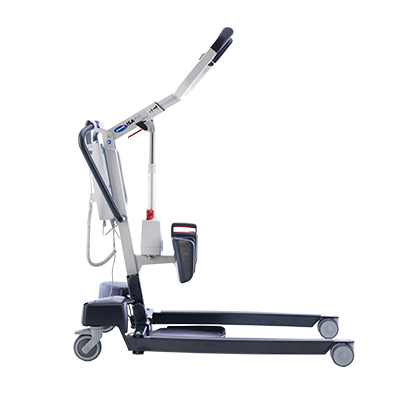
If you or a loved one needs assistance getting up from a seated position, a sit to stand lift is essential.
Whether it’s a Power or Manual lift, it is a must-have for daily activities like bathing, dressing and moving from a seated position. Here is what you need to know about sit to stand lifts.
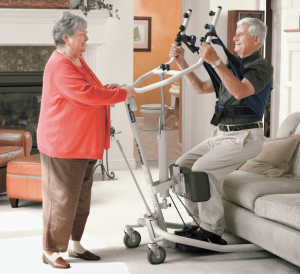
Sit to Stand Lifts are designed to assist patients who have some mobility but need help to rise from a sitting position.
They allow caregivers to easily move patients from one seated surface to another. The patient’s feet are placed securely on the platform and leg supports prevent the knees from bending.
A sling is placed around the patient’s body and the patient grabs onto the grab bars. The Sit-to-Stand lift helps the patient to rise from the seated position but does not support the patient’s entire body weight.
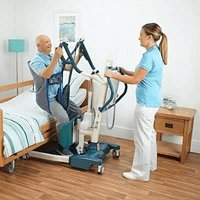
Several criteria are used to determine if a person is able to use a Sit to Stand Lift. These include:
Transfer slings can be used for cooperative patients with minimal weight-bearing ability. Full body lifts should be considered for patients who are uncooperative or unable to bear any of their own weight.
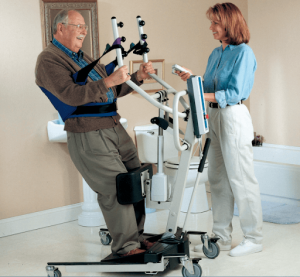
Manual Sit to Stand lifts with levers and hydraulic pumps are affordable and lightweight but not well suited for caregivers with limited strength.
Powered Sit to Stand lifts use rechargeable batteries and require virtually no effort from the caregiver.
Caregivers can adjust the base with a manual lever or electronic controls depending on the model. Powered bases are more expensive but easier for caregivers to use, especially for bariatric patients.
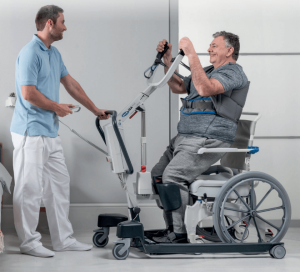
Sit-to-Stand Lifts are available with many types of options to meet the needs of patients and caregivers.
Obstruction sensors automatically stop movement of the lift if the patient or caregiver gets in the way.
Adjustable leg supports accommodate patients of various heights. Ergonomic handles allow patients and caregivers to maintain safe, comfortable grips during transfers.
Low bases are designed to fit easily underneath beds. Curved base legs allow the lift to fit around commodes and large wheelchairs. Removable foot plates allow the patient to walk with supervision after being helped to stand.
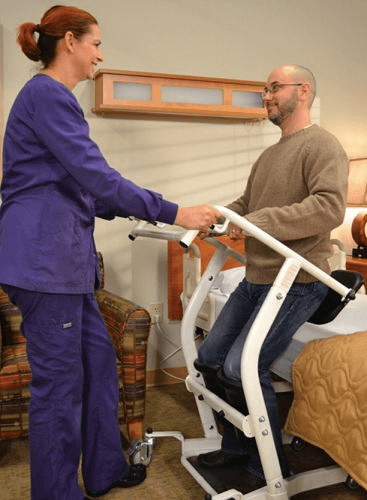
Some Manual Stand-Aids are designed to transport patients who can bear their own weight and require minimal assistance to stand. The patient grasps the middle bar and pulls up to a standing position.
An angled split seat swings into place for the patient to lean against during transport. No sling is needed. The compact, lightweight design allows caregivers to easily push the patient through narrow spaces.
A lift aid with a sling should be used for patients who require more than minimal assistance to stand.
The physician and therapy team must be consulted before choosing a patient lift and sling. Training is required to use lifts safely to prevent injury to patients and caregivers.
Final Thoughts
We hope you can get to answers most of the questions you have about sit to stand lifts. At HomeCare Hospital Beds we want to help you make an informed decision.
If you have any doubts on which sit to stand lift is best for you, please contact our HomeCare Hospital Beds team so we can help you make the right choice.
Call us today toll free at 877-414-0002 or email us at info@homecarehospitalbeds.com.




| Cookie | Duration | Description |
|---|---|---|
| cookielawinfo-checkbox-analytics | 11 months | This cookie is set by GDPR Cookie Consent plugin. The cookie is used to store the user consent for the cookies in the category "Analytics". |
| cookielawinfo-checkbox-functional | 11 months | The cookie is set by GDPR cookie consent to record the user consent for the cookies in the category "Functional". |
| cookielawinfo-checkbox-necessary | 11 months | This cookie is set by GDPR Cookie Consent plugin. The cookies is used to store the user consent for the cookies in the category "Necessary". |
| cookielawinfo-checkbox-others | 11 months | This cookie is set by GDPR Cookie Consent plugin. The cookie is used to store the user consent for the cookies in the category "Other. |
| cookielawinfo-checkbox-performance | 11 months | This cookie is set by GDPR Cookie Consent plugin. The cookie is used to store the user consent for the cookies in the category "Performance". |
| viewed_cookie_policy | 11 months | The cookie is set by the GDPR Cookie Consent plugin and is used to store whether or not user has consented to the use of cookies. It does not store any personal data. |